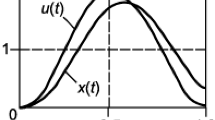Conclusions
The above method for determining the shape (design) of springs for dynamometers by means of “form factors” is suitable for judging objectively the full utilization of materials in designing springs. High values of the form factors and, therefore, a small weight of the dynamometer, are attained mainly owing to a uniform distribution of stresses in the spring. The production of springs with a minimum mass is particularly important in measuring efforts evaluated in thousands and tens of thousands of kilonewtons.
Similar content being viewed by others
Literature cited
N. M. Belyaev, Strength of Materials [in Russian], Mashgiz, Moscow (1952).
S. P. Timoshenko, Strength of Materials [in Russian], Parts I and II, Izd. Nauka, Moscow (1965).
N. G. Tokar', “Elastic dynamometers for solid-specimen test machines,” Dissertation at the VNIIM (1950).
Additional information
Translated from Izmeritel'naya Tekhnika, No. 5, pp. 39–41, May, 1968.
Rights and permissions
About this article
Cite this article
Tokar', N.G. Determining the shape of dynamometer springs. Meas Tech 11, 621–623 (1968). https://doi.org/10.1007/BF00986625
Received:
Issue Date:
DOI: https://doi.org/10.1007/BF00986625




